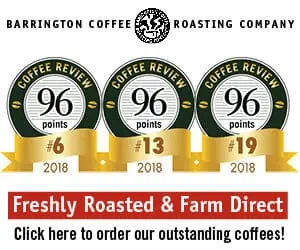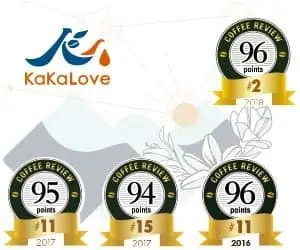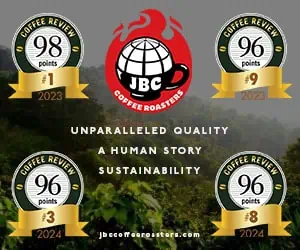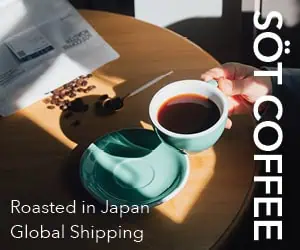Coffees that attract a high rating on Coffee Review are often produced from very small, or “micro” lots of green coffee, specially selected for quality and distinctiveness, precisely described in regard to botanical variety and other details, and not likely to be available for more than a couple of months before they’re sold out. And usually (though not always) they cost considerably more than other, more generically described coffees from the same origin or region.
For this month’s article (I am lifting some language from our “macro-lots” article from 2010) we tried to tilt the playing field away from rare and expensive coffees toward everyday staple coffees. We required that any coffee we consider for review come from a single lot of a green, unroasted coffee of at least 100 bags, or around 13,000 to 15,000 pounds. For very large roasters, of course, 100 bags is nothing, a bean in a bucket of beans. On the other hand, committing to buying at least 100 bags of a coffee for a smaller roaster implies (we hope) a sufficient commitment to that coffee to suggest that it will be available to consumers for some months and represents the sort of everyday, staple offering we are looking for this month rather than specially selected “now or never” micro-lots with equally special pricing.
Pure, Complete and Balanced
We ended up cupping thirty-two samples. Among those thirty-two were some very impressive coffees. True, most were not the sort of startlingly different coffees we often receive when we set up cuppings using criteria that encourage small lots of fancy coffees. The best of the high-rated coffees from this month’s larger lots tended to stand out simply because they were deliciously pure, complete and balanced rather than startlingly different. Most were produced from respected, though not particularly rare or precious varieties of Arabica. All but three of the thirty-two samples we tested were processed by the standard wet or washed method rather than by more unusual methods like the dried-in-the-fruit or honey methods often applied to smaller, fancier lots of coffees.
Macro-Lot Ratings
Nevertheless, the ratings for this month’s samples from larger lots were impressive – thirty-two samples averaged a rating of 89.7, with a remarkable fifteen of the thirty-two samples generating ratings of 90 or higher. This is a much better record than achieved by our last macro-lot cupping in 2010, when forty-three samples averaged a lackluster 85.5 and only three of the forty-three rated 90 or higher.
Four Years of Change
I can think of at least one reason for the striking improvement in ratings generated by this set of macro-lot coffees compared to the ratings achieved by the coffees we sourced in 2010: The medium-roasting, green-coffee-first coffee culture, sometimes shorthanded as the “third wave,” has grown in size and influence over the past four years. Four years ago two of the companies that sent us stand-out medium-roasted coffees for this month’s cupping were mostly producing darker-roasted versions of mainly generically sourced green coffees. Several of the roasters with coffees reviewed at 91 or better this month didn’t even exist four years ago, while other smaller roasters born out of the so-called third wave have grown larger and are buying larger lots of coffee.
Fair Trade/Organic Stand-Outs
Another interesting result of the cupping: A perhaps surprising percentage of all of the tested macro-lot samples – and a particularly high percentage of the highest-rated among them – were either certified organically grown or certified Fair Trade, or both. What this perhaps suggests is that the more everyday, mainstream coffees offered by small- to medium-sized roasters tend to present certification as one of their differentiating selling points, whereas certification may simply be a side issue or bonus when those same roasters are selling elite micro-lots like the ones that often dominate our reviews.
The frequently heated debate between the more outspoken supporters of Fair Trade (“the only quality that matters is quality of life for producers”) and detractors (“Fair Trade is a misguided effort to prevent market forces from rewarding coffee quality, which is the only thing that matters”), has abated. It should be clear by now to any except the most stubborn free-trade ideologues that the Fair Trade movement can produce excellent coffees, while supporters of Fair Trade appear to have become more sanguine in their support, chastened both by schisms within the Fair Trade movement and by the complex results of increasingly sophisticated, statistic-based efforts to determine the impact of Fair Trade programs on rural poverty. (An excellent summary of that research can be found in the article “The Economics of Fair Trade” at thecosa.org).
Twelve at 91 or Higher
Returning to the coffees themselves, we offer reviews of twelve of the fourteen samples that attracted ratings of 91 or higher. We omitted a 93-rated Fair Trade/organic Ethiopia from Olympia Coffee Roasting and 91-rated samples from two companies, Courier Coffee and Thanksgiving Coffee, because each of these companies already had contributed a higher-rated coffee to the reviews. We added a coffee from the large, family-owned Rogers Family Company because it represented an unusual opportunity to taste a dark-roasted version of the rare Gesha variety, in this case the San Francisco Bay Reserve 100% Panama Bay Gesha (89).
Ethiopias at the Top, As Usual
Predictably, perhaps, the two highest-rated coffees in the cupping were Ethiopias that benefited from the familiar Ethiopia edge: They were produced from varieties of coffee tree native to Ethiopia, varieties that contribute the engagingly distinctive flower, citrus and cacao notes characteristic of the best Ethiopia coffees. Nevertheless, both the Olympia Ethiopia Biloya Organic (95) and the Kickapoo Organic Ethiopian Worka (94) were conventional coffees in the sense that they were processed by the meticulous wet or washed method traditional for fine Ethiopia coffee, netting a striking layered and intricate profile for the Olympia and a cleanly nectar-like lushness for the Kickapoo. By contrast, the two Ethiopia Yirgacheffe Arichas reviewed here, the Water Avenue (93) and the CafeTaster (92), were processed by the currently fashionable but unorthodox dried-in-the-fruit or natural method. Both displayed variations on the shifty, often unpredictable impact of natural processing on the Ethiopia profile, in this case a crisp, dryish pungency that complicated the more predictable sweet floral and cidery fruit tendencies of the type.
Colombias, Burundis, More
On the other hand, the highest-rated Colombias, the Reunion Island Colombia Las Hermosas (93) and the Topéca Alto del Obispo Colombia (92) were absolutely classic coffees in the mode more familiar to the Americas: sweetly bright, impressive in their balance, displaying a complete if not intricate set of aroma and flavor notes. The Equator Peru Cajamarca Fair Trade/Organic was another very pure coffee, sweetly crisp, gently bright, a classically fine coffee in the subtle Peru mode.
We received a surprisingly large turnout of coffees from the Great Lakes Region of Central Africa. Two Burundis scored very well; the Drift Away Burundi Buhorwa (93) showed a lovely version of the characteristic Great Lakes juxtaposition of sweet and savory, in this case incorporated in complex nut and floral notes. The Courier Coffee Tkana Cooperative Dukorere Burundi (also 93) was suavely balanced, sweet and round, with only a hint of savory. Also from the Great Lakes Region, the Thanksgiving Coffee Rwanda Musasa Fair Trade (92) was exceptionally immaculate and sweet, in this case showing none of the typical Great Lakes savory edge, only a lovely, lyric sweetness.
Finally, samples from two origins that seldom find their way to our cupping table rated well. The Bootstrap Papua New Guinea Ulya Wahgi Valley (93) displayed, like so many of this month’s high-rated coffees, delicacy, poise and aromatic completeness. The Korean roaster Namusairo offered a coffee that, although representing one of the most widely used coffee types in the world, is seldom offered by North American roasters as a single origin: a dried-in-the-fruit or natural Brazil (91). Like many of this month’s high-rated coffees, it was a graceful and characteristic expression of its type: in this case, sweet, nut-toned, with a quiet but vibrant acidity.
What about Prices?
When we compare prices for the macro-lot coffees reviewed this month to prices for coffees reviewed for two recent cuppings that were heavy on fancy microlots, a considerable value edge for the macro-lots emerges. The average for the reviewed coffees in this month’s macro-lot cupping was almost exactly $17.00 per 12 ounces, whereas the average price for the coffees reviewed for a single-varieties article (Geshas and the Rest: Single-Variety, Single-Lot Coffees, November 2014) was a daunting $36.00 per 12 ounces, and the average price for Honey and Natural Coffees, Central America 2014, September 2014 was about $25.00 per 12 ounces. A fairer comparison can be gotten if we remove the very expensive Gesha coffees from all three sets of reviews, plus omit a couple of atypical outliers, in which case we obtain what is probably a more normative comparison: $15.50/12 ounces for this month’s macro-lot coffees, $19.00/12 ounces for the single-variety coffees (again, omitting the Geshas), and $18.50/12 ounces for the honey- and natural-process Central Americas.
A Last Caution
Finally, one caution on these results. In the large picture this month’s results still tend to support the idea that genuine microlots, when one can find them and afford them, offer not only a more distinctive coffee experience but also arguably a more consistently high quality experience. A few of the larger lot coffees we cupped this month that we did not review betrayed mild but clear quality issues, ranging from apparent fading from being held too long or suffering during transport, to a couple of samples that were outright tainted, including one Rwanda that startled us with a cup displaying the infamous and unmistakable potato defect.
Producers and buyers of microlot coffees typically are too aware of their reputation to risk either fading during transport or even the very mildest of processing taints. Microlot coffees, for example, are typically transported in sealed moisture-and-gas resistant 50-pound bags rather than in the larger more familiar (and perhaps more romantic) burlap or jute bags, and are often air-shipped from origin to avoid possible deterioration during long ocean transport.










